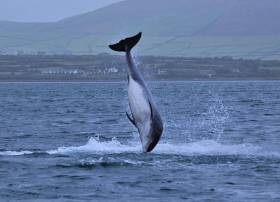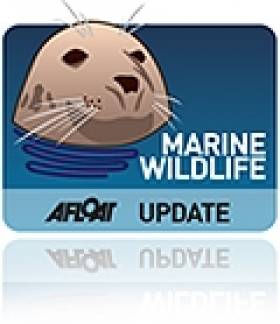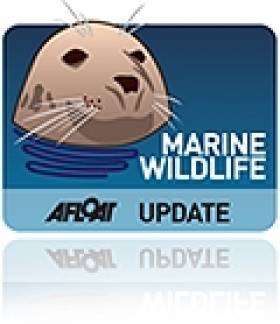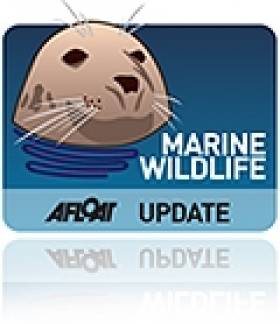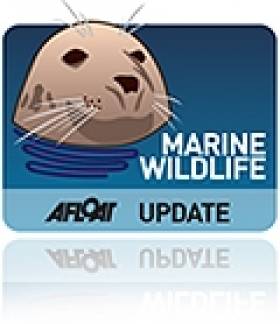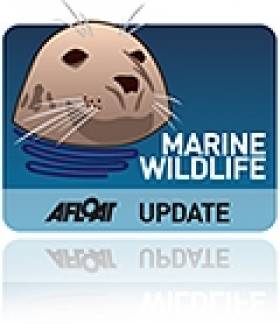Displaying items by tag: Fungie
Fungie The Dolphin Wounded By Propeller Blade
#Fungie - Dingle's resident dolphin Fungie has sustained a significant wound below his dorsal fin, as the Irish Examiner reports.
The deep cut, likely inflicted by a visiting boat's propeller, was noticed yesterday (Friday 3 June) by fans of the popular marine wildlife attraction who's delighted locals and visitors alike in Dingle for more than 30 years.
However, Fungie lovers have been urged not to panic – as the famous bottlenose has healed well from similar injuries before, and has already returned to frolicking with boaters in Dingle Harbour.
The Irish Examiner has more on the story HERE.
Fungie Surprises Seaweed Farmers With Spectacular Leap
#MarineWildlife - A pair of seaweed farmers made a friend off the Kerry coast recently when Dingle's resident dolphin decided to join them for a swim.
Mail Online has some remarkable photos of the moment when Fungie, the 40-year-old cetacean who's lived in Dingle for more than three decades, leapt out of the water alongside David Millard and Mike Murphy's boat as they made their way home from the latter's seaweed farm workplace.
"As he blasted out of the water, we got such a shock as he was so fast, so high and so close to us. The boat is only about 16 foot long and he'd be nearly the same length," said Millard.
Mail Online has more on the story HERE.
Dolphin Visitor Spotted Off Kerry Near Fungie's Waters
#MarineWildlife - Clet the dolphin, previously spotted in West Cork after migrating across the Celtic Sea from France, has moved to the waters off Kerry in close proximity to Dingle's friendly resident Fungie.
As previously covered on Afloat.ie, the Irish Whale and Dolphin Group (IWDG) warned curious humans not to get too close to the bottlenose traveller after reports of aggression against swimmers.
But according to Sunday Independent, Fungie himself should have nothing to fear from Clet's visit should the two come into contact, as fighting among dolphins is only likely if competing for a mate.
"Fungie could be 40 to 50 years old at this stage and is unlikely to be interested in mating," said the IWDG's Padraig Whooley.
That's one of the only things experts do know about Fungie, who continues to baffle marine scientists with his general behaviour that's so atypical of his species. Independent.ie has more on the story HERE.
In other cetacean news, the IWDG reports "huge success" in its just-completed expedition to Cape Verde to survey the region's whale activity, recording humpbacks breaching for the first time off Ilhéu Branco in the West African archipelago.
Take A Trip Into Fungie's World With Dingle's Resident Dolphin
#MarineWildlife - Thanks to the Daily Edge for highlighting this wonderful video of probably Ireland's favourite dolphin, posted by longtime Fungie fan Jeannine Massett.
The 15-minute short captures the friendly bottlenose in his more relaxed moods, clicking and whistling at passing boats, snacking on his favourite wild salmon, and simply sailing at peace through the waters off the Dingle Peninsula.
While it's thought by some that he may be an escapee from a British dolphinarium, Fungie's made his home in Dingle for more than three decades now, so he's an Irish dolphin through and through!
Fungie Frolics With Friends Off Dingle In New Video
#MarineWildlife - Ireland's most famous resident dolphin appears to have made some friends, as the video above shows.
TheJournal.ie reports that Fungie, who made Dingle his home 30 years ago after possibly escaping from a British dolphinarium, often shuns the friendship of dolphins from passing pods.
But this time he's made a connection with two dolphins who arrived at the Kerry village this past weekend.
Dutch couple Jeannine Masset and Rudi Schamhart, who have befriended Fungie over the past two decades, say "he gets along brilliantly" with the newcomers, who have been spotted in the area previously.
And the trio have been performing some spectacular acrobatic feats to the delight of onlookers - a good indication that despite his age, and a year on from fears of his demise, Fungie's still a calf at heart.
New Book Questions The 'Truth' About Dolphin Smarts
#MarineWildlife - The Daily Express looks to two of Ireland's resident cetaceans, Duggie and Fungie, for answers to the question of whether dolphin intelligence is truly all it's cracked up to be.
Dingle's famous dolphin Fungie should need no introduction, but the story of Duggie might be new to you: this dolphin apparently befriended a labrador named Ben after losing her own mate in the waters around Tory Island off Donegal.
Both dolphins are remarkable for the relationships they've formed with different species - see the story of a Dutch couple's bonding with Fungie over more than two decades for further evidence.
However, some scientists want to throw water on the notion that dolphins are humans' closest intellectual peers in the animal kingdom.
"In terms of intelligence they are nowhere near as special as they have been portrayed," says zoologist Justin Gregg, who has written a new book, Are Dolphins Really Smart?, that questions the widely-held wisdom that dolphins have superior brains to the likes of dogs, or that the complex sounds they make are language.
But is is really such a stretch to say that dolphins have a language of their own? Only last year US marine science boffins were baffled by a beluga whale who spontaneously mimicked human speech - in what sounded like a Donegal Irish accent.
The Daily Express has much more on the story HERE.
Dingle's Fungie May Have Come From British Dolphinarium
#Fungie - An Irish marine expert suspects that Dingle's most famous resident may be an escapee from a British dolphinarium.
Dingle Oceanworld director Kevin Flannery told the Irish Independent that Fungie the dolphin could have slipped through the sluice gates of any one of a number of dolphinariums on the south coast of England amid "huge objections to holding marine animals in captivity".
As previously reported on Afloat.ie, the male bottlenose dolphin appeared out of nowhere in Dingle's harbour in 1983 and has made his home there ever since.
In the three decades from then he has been credited with having "rescued" the village as his frolics brings countless tourists to the peninsula every year, as Flannery told the Irish Examiner.
This week's Féile na Bealtaine in Dingle celebrates the 30th anniversary of the arrival of the Kerry village's cetacean mascot, and many visitors are expected to line up for boat trips out of the harbour to meet him face to face.
While the Irish Whale and Dolphin Group (IWDG) doesn't recommend swimming with a wild dolphin such as Fungie, the group's Nick Massett describes him as "friendly, intelligent, and very aware of where people [are] in the water".
Among the festival activities this week will be a film screening and exhibits paying tribute to Ireland's own 'Flipper'.
Féile na Bealtaine runs from 2-6 May with events throughout the Dingle Peninsula.
Twitter Fears Unfounded as Dingle's Fungie is Alive and Flipping
#FUNGIE - He was the subject of rumours of his demise earlier this week - but the people of Dingle say their most famous resident, Fungie the dolphin, is alive and flipping.
A spokeswoman for Dingle Dolphin Boat Tours confirmed to The Daily Edge that Fungie is "definitely alive", and that no dolphin remains had washed up on the beach, as had been claimed on Twitter last Monday morning.
The Co Kerry fishing village is celebrating 30 years of the bottlenose dolphin's residency in its harbour. It's unclear exactly how old Fungie is, but it's presumed he was born in the mid 1970s.
Irish Central has more on the story HERE.
Thirty Years of Fungie's Frolics in Dingle
#FUNGIE - A new video posted to YouTube celebrates 30 years of Fungie the dolphin in Dingle.
The male bottlenose dolphin appeared from out of nowhere in the Co Kerry fishing village in 1983 and soon made it his home, quickly becoming an integral part of the local community.
Since his arrival Fungie has made friends and warmed hearts with people both local and across the world, such as Dutch couple Jeannine Masset and Rudi Schamhart who have been meeting him for more than 20 years.
Meanwhile, locals hope that new measures for harbour users proposed earlier this year won't bring an end to boat trips to meet Dingle's most famous resident.
Dancing Dolphins Surprise Researchers Off Donegal
#MARINE WILDLIFE - Marine researchers off the coast of Donegal were recently treated to a rare dolphin dance by a 50-strong pod, as IrishCentral reports.
The video above captures the same pod witnessed by researchers with the Irish Basking Shark Project, who were in the area off Inishowen to observe basking sharks in the coastal waters when they were surprised by the gregarious dolphin congregation.
A spokesperson for the project confirmed to IrishCentral that such large groupings of dolphins are unusual for the area, which has welcomed more than its fair share of large marine wildlife over recent months.
As previously reported on Afloat.ie, one of the first confirmed sightings of killer whales on the Irish coastline was recorded earlier this summer when a family of orcas from the Scottish Hebrides visited the same waters at the mouth of Lough Swilly.
Meanwhile, WorldIrish reports on the heartwarming tale of a Dutch couple who have bonded with Dingle's most famous non-human resident, Fungie the dolphin.
Jeannine Masset and Rudi Schamhart, who now live in Annascaul, have visited the friendly cetacean for 21 years, and their connection has inspired a fanpage on Facebook that has received responses from Fungie fans around the world.
"Fungie has enriched our lives and we want to give something back to him by offering our friendship and companionship to him," said Jeannine, "and he lets us know over and over again that he really appreciates it."


























